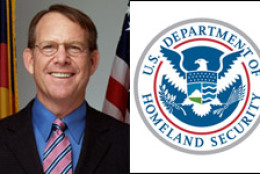Information sharing
-
The newly issued Executive Order gives NIST, DHS several goals and corresponding deadlines over the next year. NIST will work with industry to create a cybersecurity framework. DHS is expanding the information sharing program so industry can receive classified and unclassified cyber threat data more easily and more quickly.
February 14, 2013 -
Senior administration officials say the Executive Order is not a replacement for comprehensive cybersecurity legislation, but the start of a new conversation for how best to protect the nation's critical infrastructure. NIST released an RFI Tuesday as part of its effort to create a voluntary, flexible framework. And DHS will expand the number of companies the government shares classified and unclassified cyber threat information with through the Defense Industrial Base pilot.
February 13, 2013 -
The White House's new national strategy for information sharing highlights the concept of collaboration in cybersecurity efforts. Michael Daniel, the White House cybersecurity coordinator, told the Federal Drive information security and information sharing are "mutually reinforcing."
January 17, 2013 -
A decade in the making, the Army gets the nod to start deploying a multi-billion dollar computing infrastructure to support intelligence work.
December 21, 2012 -
The heads of DoD and VA met on Thursday, and decided they wanted to a plan to speed up the delivery of an integrated health record system, currently scheduled for implementation in 2017.
December 07, 2012 -
The two agencies met this week to figure out how best to implement the recommendations in a white paper from ACT-IAC. The approach detailed in the document follows closely the methodology used to develop the NIEM and FICAM standards.
December 05, 2012 -
President Barack Obama has issued new agency standards for protecting classified information from insider threats. In a Presidential Memorandum issued Wednesday, Obama provided the heads of executive branch departments and agencies the new National Insider Threat Policy as well as the minimum standards to be employed by each agency in standing up its own insider-threat programs. Details on the new policy and the standards were not made public.
November 21, 2012 -
NSA, DHS taking steps to improve information sharing by creating a set of standardized technical specifications that let machines detect cyber threats and communicate them to one another in real-time. Whole of government approach is starting to take shape when it comes to cybersecurity.
November 08, 2012 -
Mark Weatherford, DHS deputy undersecretary for cybersecurity, discusses how the National Cybersecurity and Communications Integration Center is at the core of an effort to bring government and industry closer together to respond to threats against critical infrastructure. October 25, 2012
October 25, 2012 -
More than eight years after the White House issued Homeland Security Presidential Directive-12 requiring the issuance of secure identity cards, governmentwide and agency-specific initiatives provide hope the smart cards can be more than "glorified ID cards." NIST and GSA are developing an identity exchange in the cloud. DHS and IRS are putting their cards to use at a local level for both building and computer access.
October 11, 2012 -
Congress has a lot of unfinished business to tackle during its lame duck session expected in November. The House Intelligence Committee chairman thinks new threat information could push cyber legislation up the priority list.
October 05, 2012 -
The Environmental Protection Agency partnered with the Commerce Department and National Archives to launch a new online portal aimed at streamlining the Freedom of Information Act request process for both the public and federal agencies.
October 02, 2012 -
The Information Sharing Environment is supporting a set of technology priories to promote the safe disclosure of data. In the ISE's annual report to Congress, it highlights the steps agencies have taken over the past year to move toward a culture of responsible and secure information sharing.
September 28, 2012 -
The Energy and Homeland Security departments are working with companies in the electricity sector to come up with a baseline set of cybersecurity standards. Michael Daniel, the White House cyber coordinator, said the framework is making a difference in how owners and operators secure their networks. But Rep. Mike Rogers (R-Mich.) said without liability protections expansion of these efforts isn't likely.
September 27, 2012 -
In the post-9/11 age, information sharing - between federal agencies, and across multiple layers of government - became an even more vital endeavor. The Information Sharing Environment, headed by program manager, Kshemendra Paul, has helped to improve the coordination of information sharing. Under his watch, the National Information Exchange Model has worked to break down intelligence and information stovepipes. Agencies embraced the spirit of the idea, made progress toward the administration's stated goals and the results have been apparent. Federal News Radio examines the government's information sharing efforts as part of our special report, The Obama Impact: Evaluating the Last Four Years.
September 18, 2012



